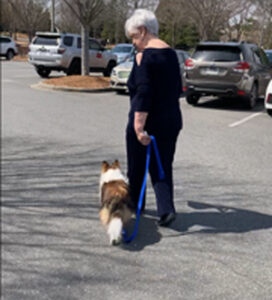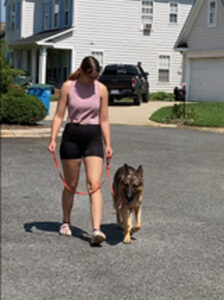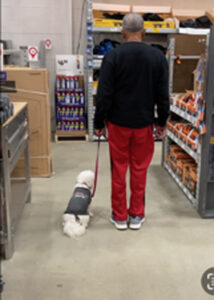Look closely at the area where your dog’s collar is clipped to his leash, as well as the angle of the leash. If either is taut, your dog will continue to pull away from you. There are three disturbing yet common practices that I observe “trainers” and pet parents engaging in with their dogs. I am not suggesting that any harm was intended.

I know pet parents love their dogs, but they’re frustrated and really don’t know what to do. I believe these methods are used as a way to control their dogs because they don’t know any other appropriate way to teach their dogs.
But there is, without a doubt, a better way; a less stressful and frustrating way without causing harm or discomfort to your dog!
NO PHOTOS OF DOGS BEING PULLED, TIGHTLY RESTRAINED, OR ON THE END OF A NOOSE (LOOPER) WILL BE SHOWN
I also believe that tightening their hold on their dog’s leash is an impulse they are not doing on purpose, and has become a habit. When I point this out to pet parents, they are surprised that they are even holding the leash that short and tight. They explain, “I didn’t realize I was doing that,” or “that’s the only way I feel I can control my dog when he sees another dog.”
Your dog should learn to walk or stay beside you on a loose leash. Take a look at the CORRECT way to walk your dog. If your dog’s leash does not look like the photos below, your dog will continue to pull.

Getting a pet parent to “LET GO” of that tight grip on the dog’s leash, which has become the norm for them, is one of the most challenging things to help a human understand.
- Pulling on the leash is at the top of the list of common complaints pet parents have about their dogs. If your dog pulls and you pull him back, he will pull even more, and so on. The fact is, you are creating a pulling contest that you won’t win! Only a demonstration of how easy it is to teach a dog to stop pulling will convince a pet parent that there is a “BETTER WAY.”
- And what about the dogs that “put the brakes on” and stop walking? Is the only solution to pull or drag them? That is just wrong on every level! It hurts the dog’s neck. It hurts the dog’s paws by dragging them on the cement and can lead to cuts and infections. As far as training is concerned, it doesn’t encourage or teach the dog to stop stopping!
- Keeping your dog at your side is the ideal position, whether you are walking your dog or standing still. However, keeping the leash so tight and short is literally forcing your dog to stay at your side. That is one surefire way to convince your dog to get away from you as soon as possible!

The tighter you hold on to your dog by the collar and leash, the more he will become agitated and try to get free. By using your strength to force your dog to stay with you, you are frightening him, making it even more difficult for him to focus on anything you say.

A little about equipment: I never could understand why anyone would knowingly use equipment that is designed to choke a dog. Yet there are dog trainers who call themselves professionals but use a noose that tightens and chokes the dog. It’s referred to as a “looper.” It was never intended for use in training. It was used to quickly secure a dog coming out of a kennel, running loose, or to move a dog from one area to another in a veterinary office.
I understand that pet parents may not know any alternative way, and absolutely do not mean to harm their dog, but anyone who refers to themselves as a dog trainer should know better than to choke a dog or recommend that method to a client.

There are many different products marketed all over the internet and in super pet stores everywhere that are designed to “help” your dog walk better with less effort for the pet parent. As a professional trainer, I do not use them because they do not TEACH your dog anything and are band-aids for the issue. However, I agree they are good alternatives to choking and will not hurt your dog.

If you want your dog to walk at your side, stay by your side, and be a wonderful companion and valued member of your family, proper professional training that lasts a lifetime is highly recommended.






